Angela Slatter's Blog, page 73
September 21, 2015
Horrorology Interviews: Reggie Oliver
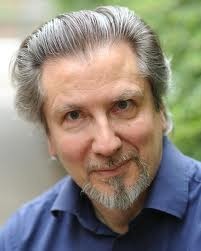 The superbly talented Mr Reggie Oliver is a playwright, author, biographer, actor and director. His Tartarus collection Mrs Midnight won the Dracula Society’s Children of the Night Award, and was a finalist for both the British Fantasy and World Fantasy Awards. Here, he talks Horrorology.
The superbly talented Mr Reggie Oliver is a playwright, author, biographer, actor and director. His Tartarus collection Mrs Midnight won the Dracula Society’s Children of the Night Award, and was a finalist for both the British Fantasy and World Fantasy Awards. Here, he talks Horrorology.
What was the inspiration for your Horrorology tale “Possessions”?
I have always wanted to write something about the sixties, in particular the dark side of its glamour: the rapacious greed of its hedonism, the male exploitation of sexual liberation. I was a young teenager in that decade living in London and found it all thrilling. One film that superbly captures that era in all its glitter and seediness is Antonioni’s Blow Up. The image of the young and then beautiful David Hemmings as the photographer in that film standing over the prone body of one of his models, pointing his camera down at her, as if raping her with it, was a starting point… That coupled with pictures of David Hemmings towards the end of his life, paunchy, unglamorous, disappointed, an Adonis no longer.
Can you remember the first story you read that made you think “I want to write!”?
Oh, undoubtedly it was Sherlock Holmes, but I couldn’t say which one, though possibly The Hound of the Baskervilles, the first novel I ever read to myself. Conan Doyle’s horror tales too – “The Leather Funnel” for example – were equally an influence. My first attempts at writing were nearly all imitations of Doyle in his horror or detective story modes.
Is horror a sort of natural home for you or do you lean more towards another part of speculative fiction? 
Yes, though I have sometimes chafed at the term “horror” simply because some people (mostly literary snobs) have such limited expectations of it. By it they tend to mean a lot of blood and sordid sex, and physical torment. And, while I don’t entirely reject that side, I do think there’s a lot more to it than that. I like the term that Charles Williams used for his “speculative fiction”: “spiritual shockers”. If I could be seen as a writer of “spiritual shockers” I’d be happy.
You’re offered the chance to visit the Library of the Damned ? do you accept?
Oh yes. I’m with the African/Roman dramatist Terence on this. “Homo sum, humani nihil a me alienum puto.” “I am a human being I count nothing human alien to me” – even “damned” humanity.
The future of horror is … ?
Exceptionally dark and exceptionally bright, a sort of “divine darkness”, as St John of the Cross would have called it, especially when placed in the hands of Angela Slatter, Clive Barker, Steve Jones, in fact any and all of the contributors to Horrorology. I really think this is a great age for horror, because of its exceptional variety and inventiveness.
Pre-order your copy of Horrorology: The Lexicon of Fear here!
September 20, 2015
Horrorology Interviews: Ramsey Campbell
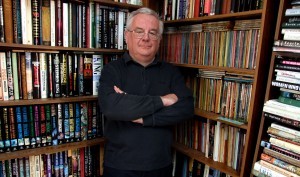 What can one say about Master Ramsey Campbell that truly shows the extent of his influence in the genre, not to mention the breadth of his talent? A poor attempt might go thusly:
What can one say about Master Ramsey Campbell that truly shows the extent of his influence in the genre, not to mention the breadth of his talent? A poor attempt might go thusly:
The Inhabitant of the Lake and Less Welcome Tenants, his first collection was published in 1964 by the Arkham House imprint. His novels have included The Doll Who Ate His Mother, The Hungry Moon, and The Darkest Part of the Woods. His short fiction has been collected in Waking Nightmares, Alone with the Horrors, Just Behind You, and Told by the Dead. He has edited myriad anthologies, including Uncanny Banquet, New Tales of the Cthulhu Mythos, and Gathering the Bones: Original Stories from the World’s Masters of Horror with Dennis Etchison and Jack Dann.
He is not only a writer but a film reviewer and a multi-award winner: multiple World Fantasy, British Fantasy and Bram Stoker Awards, the World Horror Convention Grand Master Award, the Horror Writers’ Association Lifetime Achievement Award, the Howie Award of the H.P. Lovecraft Film Festival for Lifetime Achievement, and the International Horror Guild’s Living Legend Award.
What was the inspiration for your Horrorology tale “Nightmare”?
As many of my tales do, it originated in an everyday setting that suddenly took on a darker aspect, at least in my head. The setting was a bunch of recently built streets – a suburb off the Wirral Way, a nature trail we often walk along. The notion of being lost in a mundane suburb that begins to prove worse than unhelpful occurred to me, and I took some of the elements the place included, not least the lost pet posters, a common sight these days. In the writing the tale left behind some of the developments I’d meant to include, and there may be enough of them to make up a separate story in time.
Can you remember the first story you read that made you think “I want to write!”?
I can’t identify just one, I’m afraid. I was reading from an unnervingly early age – Hans Andersen and George Macdonald before I was five, Edith Wharton and M. R. James (both in Fifty Years of Ghost Stories) by the age of six, “The Colour out of Space” at seven… All these must have spurred me in their different ways, but as far as I can see the first thing based on a recognisable source that I wrote (when I was around seven) was the start of a science fiction novel called Dogs in the Stratosphere and mercifully unfinished – lost as well. It derived from Clifford Simak’s City, then a favourite novel of mine, but he should in no way be blamed for my grisly imitation.
Is horror a sort of natural home for you or do you lean more towards another part of speculative fiction?
I’m guessing you already know the answer. Let me quote myself from elsewhere.
I’m Ramsey Campbell. I write horror.
That’s how I introduce myself at readings and on panels, and I should have thought it was straightforward enough to be uncontentious. Perhaps not, because my saying so at a British Fantasy Convention offended a splattery writer, apparently for presuming to claim a name rather than because he found my fiction insufficiently horrible for his taste. Nevertheless I’ll continue to announce myself that way, in conversation too if the opportunity arises. I quite enjoy being told that people don’t like horror, which they don’t read (a situation that prompts me to ponder how they can know). Sometimes they even tell me that they don’t like the sort of thing I write, although they haven’t read it. On occasion they approach me to let me know as much. Admittedly the sort of fun this affords is limited, and I think there’s a better reason for me to keep up the image. I believe I’m in a minority of writers who say that they write horror.
Some of those who made their name with it seem eager to show they’ve moved on. Some  might even like to convince us that they never entered the field, and seek to erase all traces of their presence as they flee the scene of the crime. I won’t be doing either. Perhaps I was lucky to encounter the classics of the genre first – anything that found its way between hard covers and into the public library – but I’ve never faltered in my conviction that horror is a branch of literature, however much of it lets that tradition down. I started writing horror in an attempt to pay back some of the pleasure the field has given me, and I haven’t by any means finished. I don’t expect to choose to, ever.
might even like to convince us that they never entered the field, and seek to erase all traces of their presence as they flee the scene of the crime. I won’t be doing either. Perhaps I was lucky to encounter the classics of the genre first – anything that found its way between hard covers and into the public library – but I’ve never faltered in my conviction that horror is a branch of literature, however much of it lets that tradition down. I started writing horror in an attempt to pay back some of the pleasure the field has given me, and I haven’t by any means finished. I don’t expect to choose to, ever.
I’ll just add that when Liverpool John Moores University gave me an honorary fellowship for (their phrase) “outstanding services to literature”, I said at the beginning of my speech that I would like to accept the honour on behalf of my field as well.
You’re offered the chance to visit the Library of the Damned ? do you accept?
If it contains books, by all means.
The future of horror is … ?
As vital as ever, I’m quite sure. Whenever the field is declared dead (and indeed, at other times as well) it produces new talents.
Pre-order your copy of Horrorology: The Lexicon of Fear here!
September 17, 2015
Horrorology Interviews: Lisa Tuttle

American-born, UK-based Lisa Tuttle is a writer of science fiction, fantasy, and horror as well as an editor and reviewer. She was the 1974 winner of the John W. Campbell Award for Best New Writer, won the 1989 BSFA Award for Short Fiction for “In Translation”, and the 2007 International Horror Guild Award for “Closet Dreams”.
Her novels include the Locus Award-nominated Windhaven (with George R. R. Martin), Lost Futures (nominated for the Arthur C. Clarke and James Tiptree, Jr. Awards in 1992), and The Silver Bough. Her short story collections include Memories of the Body: Tales of Desire and Transformation and Ghosts and Other Lovers. Her non-fiction works include Encyclopedia of Feminism and Heroines: Women Inspired by Women.
What was the inspiration for your Horrorology tale “Vastation”?
Many years ago, reading Leon Edel’s biography of Henry James, I was struck by his description of something that happened to the writer’s father — also named Henry James. Here’s the relevant passage: “One day, toward the end of May 1844, the elder Henry James ate a good meal and remained at the table after his wife and boys had left it. The afternoon was chilly and there was a fire in the grate. He gazed contentedly into the embers ‘feeling only the exhilaration incident to a good digestion.’ Relaxed, his mind skirting a variety of thoughts, he suddenly experienced a day-nightmare. It seemed to him that there was an invisible shape squatting in the room ‘raying out from his fetid personality influences fatal to life.’ A deathly presence, thus, unseen had stalked from his mind into the house.” (from Henry James: The Untried Years 1843-1870 by Leon Edel, copyright 1953) These days, something like that would probably be defined as a nervous breakdown, and doctors in those days took a similar attitude, telling James he had overworked his brain and needed to rest. But James felt it was something else; and attempted to figure out of the evil creature he had seen had come from his own mind or from another realm, eventually finding an answer that worked for him in the writings of Emmanuel Swedenborg. When Steve Jones asked me if I’d like to contribute to his lexigraphical anthology, the word that came immediately to my mind was “vastation” — the Swedenborgian term that Henry James Sr gave to the above-described experience. I was pretty sure nobody else would have beaten me to that word — and I was right.
Can you remember the first story you read that made you think “I want to write!”? 
Well, no ? because I can’t actually remember a time when I didn’t want to write, as well as read, stories. So the inspiration probably came even before I could read, from one of the children’s books my parents read to me, or even from the pictures I had to interpret to myself, lacking the ability to read the words that would have explained them.
Is horror a sort of natural home for you or do you lean more towards another part of speculative fiction?
Although I am not entirely easy with calling myself a “horror writer”, I have always been drawn to the weird, the strange and the supernatural in fiction. That is certainly my natural territory. Even though when I first began getting published in the 1970s I was identified as a “science fiction writer” most of my stories (and they were all short stories then; it took a long time for me to feel ready to write a novel) would probably be better identified as horror or fantasy. But SF was the dominant genre then; there were few markets for weird and supernatural short stories.
You’re offered the chance to visit the Library of the Damned ? do you accept?
Well, I’d probably want to check it out on the internet first, find out what people were saying on TripAdvisor and so on. I’d need to give it some thought.
The future of horror is … ?
Even if I knew, I wouldn’t be allowed to tell!
Pre-order your copy of Horrorology: The Lexicon of Fear here!
September 16, 2015
Horrorology Interviews: Kim Newman
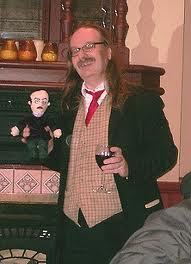
Kim Newman is one of my favourite writers; I do like to think of him as the Dandy Highway Man of Horror. He is, among other things, a superb writer, a perceptive critic, and an inveterate wearer of cravats.
What was the inspiration for your Horrorology tale “Guignol”?
I think they’re all worn on the sleeve, for a change – I was thinking of pretty much everything that was happening in France in the late 1890s, and the way French history and culture fed into the gruesome type of theatre known as Grand-Guignol, and mapping that onto more recent trends in explicit horror. It’s part of a cycle I’ve been writing called Angels of Music, which will turn up as a book in the near future – and that’s a gloss on Charlie’s Angels and the Phantom of the Opera, playing with the adventuresses of 19th and 20th century fiction. I’ve done stories riffing on Stoker, Stevenson and Doyle, so this time I looked to French creators like Gaston Leroux, Louis Feuillade, Alfred Jarry and Oscar Metenier for source material. My first trio of angels was Christine Daae (from the Phantom of the Opera), Irene Adler (from Conan Doyle) and Trilby (from George du Maurier) … but this story features Kate Reed (from Bram Stoker, very loosely), Clara Watson (from Octave Mirbeau and the Grand-Guignol adaptation of Torture Garden) and Yuki Kashina (from the Lady Snowblood films). Having used well-known characters earlier, I wanted to go with less familiar folks this time – Kate, whom I’ve been developing in my Anno Dracula and Diogenes Club stories, gets a Paris holiday and is very much the lead this time round. I listened to a lot of Offenbach while and watched a lot of video nasties writing the piece. The Angels of Music will return in Phantom Ladies Over Paris.
Can you remember the first story you read that made you think “I want to write!”?
‘The Sea Raiders’ by HG Wells. It’s the one about killer jellyfish.
Is horror a sort of natural home for you or do you lean more towards another part of speculative fiction? 
As a critic, I spend a lot of time putting books and films into genre boxes, but as a writer I tend to try to escape from them. I think I write Kim Newman stories rather than horror or science fiction or whatever – though I have used titles like ‘Another Fish Story’ and An English Ghost Story to signify my attempts at staying neatly inside the box while trying to do things that interest me with the forms – but that’s a good thing, since no one else is going to write them, really.
You’re offered the chance to visit the Library of the Damned ? do you accept?
I am fond of libraries … though I let more invitations slide than take them up these days.
The future of horror is … ?
Clive Barker stamping on a human face forever?
Pre-order your copy of Horrorology: The Lexicon of Fear here!
September 15, 2015
GenreCon Program is live, live, live!
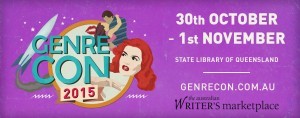 Yup, if you’re coming to Brisbane for GenreCon at the end of October (and why wouldn’t you be?) the program is here.
Yup, if you’re coming to Brisbane for GenreCon at the end of October (and why wouldn’t you be?) the program is here.
On Saturday 31 October I’ll be running this two-hour workshop:
1:30 PM – 3:30 PM
BEST FOOT FORWARD: EDITING AND POLISHING YOUR SHORT FICTION
Presented by Angela Slatter, QWC Learning Centre
Self-editing can be one of the most challenging aspects for writers at every stage of their career. Best Foot Forward will show you what issues to look for and teach you the techniques of flensing, improving, and polishing up your own work.
AND!
On Sunday 1 November I’ll be on this panel:
11:30 AM – 12:30 AM
THE FIVE BOOK THEORY
Auditorium 1
Chair: Josh Melican; Panelists: Angela Slatter, Keri Arthur, Kim Wilkins
New York Agent Donald Maas has offered the theory that a writer’s career only takes off around the fifth or sixth book. We’ve brought together three authors who have passed that milestone to discuss how their careers have changed.
When Kathleen Jennings says …
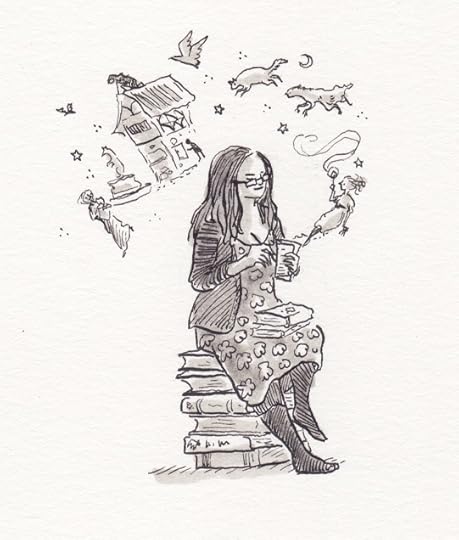
Author by Artist
… “Do you want art with that?” you ALWAYS say “Yes!”
This is why.
Horrorology Interviews: Joanne Harris
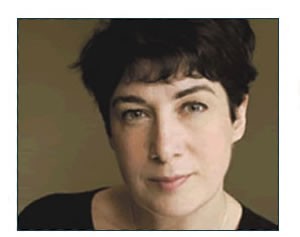
Joanne Harris (MBE) studied Modern and Mediaeval Languages at Cambridge and was a teacher for fifteen years, during which time she published three novels, including Chocolat (1999), which was made into an Oscar-nominated film starring Juliette Binoche and Johnny Depp.
Since then, she has written 14 more novels, two collections of short stories and three cookbooks. Her books are now published in over 50 countries and have won a number of British and international awards. She is an honorary Fellow of St Catharine’s College, Cambridge, has honorary doctorates in literature from the universities of Sheffield and Huddersfield, and has been a judge for the Whitbread Prize, the Orange Prize, the Desmond Elliott Prize and the Royal Society Winton Prize for Science.
What was the inspiration for your Horrorology tale “Faceless”?
I wrote it while I was staying alone in an old parsonage in Oxford. It was snowing; there was no internet or phone line; the house was enormous, ancient and (I thought) visibly haunted. What else could I do?
Can you remember the first story you read that made you think “I want to write!”?
Ray Bradbury’s short story: THE SMILE.
Is horror a sort of natural home for you or do you lean more towards another part of speculative fiction?
I write all kinds of things. My first novel was a horror story, but I like to explore all areas of speculative fiction, including fantasy, sci-fi and magical realism.
You’re offered the chance to visit the Library of the Damned – do you accept? 
Of course. Is there tea?
The future of horror is … ?
Inside us all, awaiting its chance to break out again through the pitiful veils of rationality and reassurance we like to drape around ourselves …
Pre-order your copy of Horrorology: The Lexicon of Fear here!
September 14, 2015
Tor.com Sweepstakes!
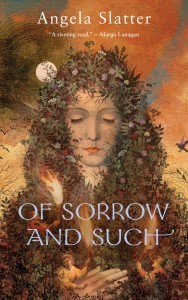 Tor.com are giving away three galley copies of Of Sorrow and Such – but only to the US and Canada (although not Quebec, for some reason – I’m sorry, Quebec, I’ll make it up to you).
Tor.com are giving away three galley copies of Of Sorrow and Such – but only to the US and Canada (although not Quebec, for some reason – I’m sorry, Quebec, I’ll make it up to you).
So, go here to enter.
Horrorology Interviews: Mark Samuels
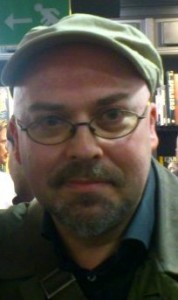
Mark Samuels (born 1967) is the author of five short story collections: The White Hands and Other Weird Tales (Tartarus Press 2003), Black Altars (Rainfall Books 2003), Glyphotech & Other Macabre Processes (PS Publishing 2008), The Man who Collected Machen & Other Stories (Chomu Press 2011) and Written In Darkness (Egaeus Press 2014) as well as the short novel The Face of Twilight (PS Publishing 2006). His tales have appeared in many prestigious anthologies on both sides of the Atlantic including The Mammoth Book of Best New Horror , Year’s Best Fantasy and Horror , The Weird , and A Mountain Walks.
What was the inspiration for your Horrorology tale “Decay”?
The tale is a satire on the advance of internet technology accelerating the decay of complex human reasoning. With the rise of online tools like twitter, facebook, etc. etc., one finds, in order to communicate with a mass audience, participants limit their ideas to slogans, advertising, sound-bites, and the dictates of peer pressure. Moreover, in order to communicate – other than very briefly at the level of a truncated mass shouting match! – civilly, interactions within the system require certain shared and often unexamined philosophical and political assumptions. “Decay” also satirises the current fad of believing that human level sentience is a simply a matter of achieving, in a machine, either a high enough degree of brute computational power and/or the requisite algorithmic programming.
Can you remember the first story you read that made you think “I want to write!”?
I can’t recall that there was a single story that made me determined to become a dedicated writer. I do remember certain tales that impressed me in my early teens, mainly the Sherlock Holmes series of detection adventures and macabre tales by Poe and Lovecraft. Back in the 1980s, it was a case of undergoing something like an apprenticeship within the fanzines and honing one’s craft. I garnered a large number of (very justified) rejection slips at the time. It was during a later period, during the mid 1990s, that my reading in all forms of literature expanded dramatically, and my own efforts began to improve. Though my first published story was in 1988, I don’t believe I considered actually self-identifying primarily as a writer, even of the very obscure and almost “underground” type I am now, until quite recently.
Is horror a sort of natural home for you or do you lean more towards another part of speculative fiction?
I don’t sit down at my laptop thinking “now to write another horror tale (heh, heh, heh)”. I think my imagination tends to be stimulated and to operate along certain thematic lines and that the sense of the profound mystery behind existence itself is what really fires my imagination into life.
You’re offered the chance to visit the Library of the Damned – do you accept? 
I doubt it.
The future of horror is … ?
One usually gets two types of responses to this. Here goes:
The first is along the lines of a request (very often, and most vocally, from old white males themselves) that greater inclusiveness is the future, that a higher proportion of female and minority writers must be afforded greater exposure. Personally, I think true equality consists of treating everyone on the same artistic basis, not a quota basis, and the final criterion for acceptance should be the actual quality of the fiction submitted, not gender, not ethnicity, not disability and not any other factor. What matters is the imagination and the skill of an author in telling a tale. Nothing else. I certainly do not subscribe to the view that individual old white men are, for any reason, more intrinsically capable of writing quality horror fiction than individuals drawn from any other category in society. But the idea that extrinsic political considerations be the benchmark for judging a work of fictional composition is, I contend, a species of patronisation.
The second common response is along different lines. Horror has entrenched itself into the movies and the vast majority of people no longer read books anyway. Successful (I mean highly commercially successful) horror authors had either better write a novel that can be turned into a Hollywood blockbuster film or else produce a body of work that can be utilised as a movie franchise. It’s not a vision that inspires me in the slightest. The other thing to bear in mind, and it was a staple view in the 1990s and the 2000s – but, it seems has finally, and mercifully, died off – is that there will be no return to the likes of the “horror boom” of the 1970s and 1980s in publishing. The decline of literacy has advanced to such a degree that the days of such cycles in publishing are over. The end was in sight when conglomerates took over all the smaller publishing houses that used to proliferate. Now the small press, with one or two notable exceptions, is all that remains for those who might once have been mid-list mass market authors of horror story collections (not anthologies) or novels that are not the size of a brick.
My own view is this: writers will continue, in the future, to work in this continuum of fictional composition (parts of which have been labelled “horror” or “weird” etc. for quite some decades now) as they have always done. No single author, no matter how masterful, is the summation of that continuum. And the label itself certainly isn’t important except for outside factors not connected with literary artistry, like commercial marketing. Ideally, the impetus for the author to engage in that continuum should come from within, and not from without.
Pre-order your copy of Horrorology: The Lexicon of Fear here!
Random Alex on Of Sorrow and Such
 And another review for Of Sorrow and Such! Thanks, Alex!
And another review for Of Sorrow and Such! Thanks, Alex!
Firstly, LOOK AT THAT COVER OH MY IT IS A THING OF BEAUTY.
Secondly, Margo Lanagan is right, as usual. This is a riveting read.
Mistress Gideon, the narrator, is not a nice person. She’s not a good person, either; she works for and wants the best for those she loves, and for that reason is a fierce and loyal friend… but she’s not nice. And she’s not good. She is terrible to her enemies.
For the rest, go here.



